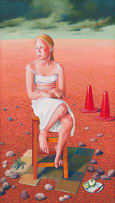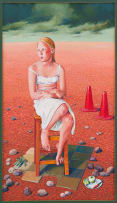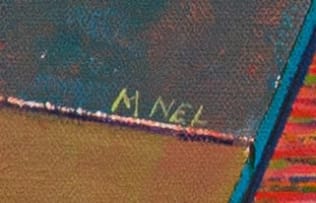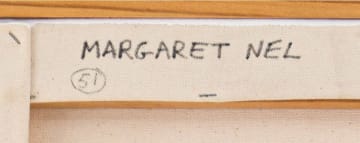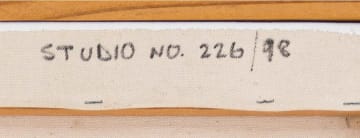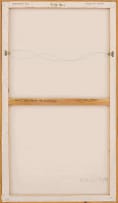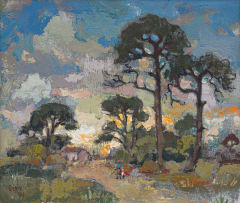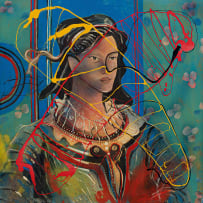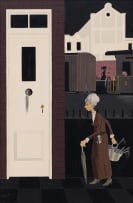Modern, Post-War, Contemporary Art
Live Virtual Auction, 7 - 8 November 2021
Evening Sale
Incl. Buyer's Premium & VAT
About this Item
signed and dated '98/'99 and inscribed with the title on the reverse
Notes
Completed in 1999, Waiting for the Renaissance is layered with fin de siècle symbolism, marking both the close of the millennium and the end of Nel's postmodern period, which centred on compositional complexity, eclecticism and sociopolitically-charged commentary. Modelled on her then teenage daughter, the figure of the ill-fated ingénue is also a personification of the artist herself. Poised between apprehension and anticipation, she is a complex and contradictory figure. Isolated, exposed and clad only in flimsy undergarments that offer little protection, she seems entirely ill-prepared for the barren, unforgiving landscape in which she finds herself. Her skin bears the effects of the unrelenting African sun, and dark clouds threaten rain that never seems to materialise. Like Peter Schütz's martyred Catholic saints in 1998 Icons and Idols exhibition at the Goodman Gallery in Johannesburg, the central female figure in Waiting for the Renaissance represents the universal Other, the outsider relegated to the margins of relevance, existing in a no-man's land of their own or others' making. She is surrounded by stones, which will presumably cause her injury or death. She is a martyr, a biblical pariah, a sacrificial figure. A partially peeled apple, frequently employed by Nel to represent loss of innocence, references the nascent sexuality of the pubescent figure and symbolises the premature transition from an Arcadian age of innocence to worldliness and disenchantment.
While all of Nel's work from this period can be read in relation to issues pertinent to the time - South Africa's uncertain democratic transition, the Burundian and Rwandan genocides, and notions of environmental degradation - they are equally relevant to current issues of ostracism, social displacement, exodus, migration and climate change. The title references former president Thabo Mbeki's much publicised 1998 'African Renaissance' address, which championed, perhaps idealistically, the continent's imminent political and cultural rebirth. The unforgiving, drought-stricken landscape - a quintessentially South African trope - here serves as a symbol for inadequate physical and emotional preparedness for the future.
Kelda van Heerden
Exhibited
Pretoria Arts Association, Pretoria, and the ABSA Gallery, Johannesburg, Leonardo Posted, a group exhibition coinciding with, and responded to, the touring exhibition at the Pretoria Art Museum entitled Leonardo da Vinci: Scientist, Inventor, Artist, 1999.
Kempton Park/Tembisa Fine Arts Award, Kempton Park, 1999.
African Window Museum, Pretoria, Margaret Nel: Barriers, 5 to 29 September 2000.
Pretoria Art Museum, Pretoria, A Retrospective 1970-2017, 2017.
Literature
Staff reporter (1999) 'n Uitstalling waarin kunstenaars hul interpretasie van Leonardo da Vinci moes weerspieël, 16 May, illustrated in the background of a colour photograph of the artist and her daughter at the exhibition.

